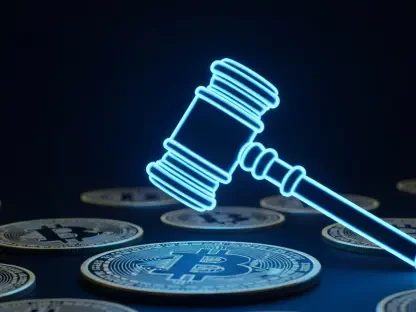Introduction to the Dodd-Frank Act and U.S. Financial Landscape
In the heart of the U.S. economy, the financial sector stands as a powerhouse, driving global markets with trillions of dollars in daily transactions, yet its vulnerability was starkly revealed during the catastrophic 2007-08 financial crisis that shook the world. Before that collapse, the industry operated with minimal oversight over complex instruments like derivatives, fueling unchecked risk-taking that led to massive losses and government bailouts. After the crisis, a transformed landscape emerged, marked by heightened scrutiny and a pressing need for reform to prevent another meltdown. The Dodd-Frank Wall Street Reform and Consumer Protection Act, enacted in 2010, became the cornerstone of this overhaul, aiming to address systemic weaknesses and restore confidence in a battered system.
This landmark legislation targets a broad spectrum, from traditional banks to nonbank financial entities, derivatives markets, and consumer safeguards, reshaping how the industry operates. Key players, including major institutions like JPMorgan Chase and Goldman Sachs, alongside regulatory bodies such as the Federal Reserve and the Securities and Exchange Commission (SEC), now navigate a stricter environment influenced by rapid technological advancements like fintech platforms. The act’s introduction marked a significant shift in the regulatory framework, responding to years of lax oversight and setting a new standard for financial accountability in the United States.
The broader context leading up to this reform was one of escalating risk and inadequate controls, where the crisis exposed gaps that demanded immediate action. Dodd-Frank’s significance lies in its comprehensive approach to oversight, aiming not just to react to past failures but to proactively mitigate future threats. This report delves into the act’s origins, provisions, challenges, and long-term impact on the financial sector, offering a detailed examination of its transformative role.
Historical Context and Driving Forces Behind the Act
Roots of the 2007-08 Financial Crisis
The financial crisis that erupted over a decade ago originated from the collapse of the subprime mortgage market, where risky loans were bundled into securities and sold with little regard for underlying stability. Compounding this issue, over-the-counter derivatives, often opaque and unregulated, amplified risks across institutions, while excessive leverage at investment banks created a house of cards ready to fall. These factors intertwined to create a perfect storm, threatening the entire economic structure with unprecedented consequences.
High-profile collapses, such as those of Bear Stearns and Lehman Brothers, highlighted the dangers of “too-big-to-fail” institutions, whose failures could drag down interconnected markets. The ripple effects endangered even FDIC-insured banks, exposing how deeply systemic risks had permeated the industry. Government interventions, including the Troubled Asset Relief Program (TARP), became necessary to stabilize the chaos, yet they also revealed glaring regulatory deficiencies that had allowed such vulnerabilities to fester unchecked.
These events underscored the urgent need for a robust framework to monitor and manage risks that could destabilize the economy. The crisis served as a wake-up call, demonstrating that without stringent oversight, the financial sector’s interconnectedness could become a liability rather than a strength. This realization paved the way for legislative action to address the root causes and prevent history from repeating itself.
Legislative Response and Economic Impact
The economic fallout from the crisis was staggering, with millions facing foreclosures, widespread job losses, and a profound erosion of public trust in financial institutions. This devastation created an undeniable demand for reform, pushing policymakers to craft a response that could rebuild stability and accountability. The result was a sweeping legislative effort to tackle the systemic issues head-on, ensuring the economy could withstand future shocks.
Under President Barack Obama, the Dodd-Frank Act was drafted and passed, named after Senator Chris Dodd and Representative Barney Frank, who spearheaded the initiative through key congressional committees. Signed into law in 2010, it represented one of the most comprehensive regulatory overhauls in decades, aiming to curb risky practices and protect consumers. The act’s passage was met with mixed reactions, as markets grappled with the uncertainty of new rules while acknowledging the necessity of change.
Initial implementation showed early signs of impact, with data indicating a gradual increase in transparency and capital reserves among banks, though full stabilization remained a long-term goal. The economic recovery that followed was slow, but the act’s framework provided a foundation for rebuilding trust. Over time, its objectives have focused on creating a resilient system capable of withstanding unforeseen challenges, marking a pivotal shift in financial governance.
Key Provisions and Core Themes of the Dodd-Frank Act
The Dodd-Frank Act spans 16 titles, each addressing specific facets of financial regulation with a focus on mitigating systemic risk, enhancing transparency, and bolstering consumer protection. Among its most notable components are the creation of the Financial Stability Oversight Council (FSOC), tasked with identifying and managing systemic threats, and the Consumer Financial Protection Bureau (CFPB), designed to shield consumers from unfair practices. These bodies represent a fundamental restructuring of oversight to address vulnerabilities exposed by the crisis.
Other critical provisions include the Volcker Rule, which limits proprietary trading by banks to reduce speculative risks, and reforms targeting derivatives markets under Title VII to ensure standardized reporting and centralized clearing. Title XIV focuses on mortgage lending reforms to curb predatory practices, while structural changes, such as the elimination of the Office of Thrift Supervision, streamline regulatory authority under existing agencies. Together, these measures tackle the direct causes of the crisis, from risky investments to deceptive lending.
Balancing the stringency of these regulations with the operational needs of the financial industry remains a persistent challenge. While the act imposes necessary constraints, critics argue that overly tight rules can stifle innovation and competitiveness. Navigating this tension is central to the act’s effectiveness, as regulators aim to safeguard stability without hampering the sector’s ability to drive economic growth.
Implementation Challenges and Regulatory Evolution
Rolling out the Dodd-Frank Act has not been without significant hurdles, as political opposition and industry resistance have repeatedly tested its durability. Legal challenges have targeted key provisions, with some arguing that the regulations impose undue burdens on financial institutions. This pushback has led to modifications, such as relaxations of the Volcker Rule, reflecting ongoing debates over the scope of regulatory intervention.
Funding shortages have also impacted certain aspects, notably Title XII’s efforts to expand access to mainstream banking services for underserved communities, alongside administrative delays in rule-making processes. Constraints on the CFPB’s authority, particularly under shifting political leadership, have further complicated enforcement efforts. These obstacles highlight the practical difficulties of translating legislative intent into actionable policy across a complex industry.
To counter these issues, strategies have included regulatory adjustments to refine overly restrictive measures and bipartisan initiatives to sustain core reforms. The dynamic nature of financial regulation continues to evolve in response to economic shifts and political climates, ensuring that the act remains a living framework. Adapting to these changes is crucial for maintaining its relevance in addressing contemporary challenges within the sector.
Regulatory Landscape and Compliance Under Dodd-Frank
The act has fundamentally reshaped the regulatory environment, with entities like the FSOC, CFPB, Federal Deposit Insurance Corporation (FDIC), SEC, and Commodity Futures Trading Commission (CFTC) playing pivotal roles in oversight. Capital and leverage requirements now impose stricter standards on banks to enhance resilience, while rules on derivatives mandate transparency through centralized clearing and electronic trading platforms. These changes aim to create a more accountable system across diverse financial activities.
Compliance burdens have significantly altered business practices, pushing institutions to invest heavily in risk management and reporting systems to meet regulatory demands. While this has strengthened stability, it has also raised concerns about the impact on innovation, as smaller firms struggle with the costs of adherence. The act’s emphasis on transparency seeks to mitigate hidden risks, yet it sparks ongoing discussions about the balance between oversight and operational flexibility.
Debates persist over whether the regulatory framework leans too heavily toward control, potentially stifling growth, or if robust measures are essential to prevent future crises. Striking this equilibrium remains a central issue for policymakers and industry stakeholders alike. As compliance evolves, the focus remains on ensuring that safeguards are effective without unduly constraining the sector’s ability to adapt to new market realities.
Future Outlook for Dodd-Frank and Financial Regulation
Looking ahead, the Dodd-Frank Act faces an evolving landscape shaped by financial technologies such as fintech solutions and digital assets, which introduce both opportunities and risks. Regulators must adapt to these innovations, ensuring that frameworks keep pace with rapid advancements while addressing potential vulnerabilities. The rise of decentralized finance and cryptocurrencies, for instance, poses unique challenges to traditional oversight models.
Emerging market disruptors and shifting consumer expectations for transparency and accessibility further complicate the regulatory environment. Consumers now demand greater protection and clarity in financial services, pushing for reforms that align with modern needs. Global economic conditions and political dynamics also play a critical role, influencing the act’s longevity and shaping how it responds to international pressures and domestic priorities.
Innovation in areas like data-driven regulation offers promising avenues for enhancing oversight, with predictive analytics potentially identifying risks before they escalate. Predictions for legislative adjustments include possible expansions to cover new financial instruments or targeted amendments to streamline existing rules. The act’s future hinges on its ability to remain flexible, addressing novel threats while maintaining core protections that underpin market stability.
Conclusion and Prospects for U.S. Financial Stability
Reflecting on the journey, the Dodd-Frank Act carved a transformative path in financial regulation, embedding stability and transparency into the U.S. system through its comprehensive reforms. Its achievements in curbing systemic risks and enhancing consumer protections stand as critical milestones, even as political volatility and incomplete objectives, such as broader banking access, pose lingering challenges. The act’s legacy emerges as a resilient yet adaptable framework, safeguarding the economy against past vulnerabilities.
Moving forward, strengthening this framework demands sustained funding for key agencies like the CFPB and proactive adaptation to emerging risks like digital currencies. Policymakers need to prioritize bipartisan support to ensure enduring reforms, while industry players must embrace compliance as a driver of trust rather than a burden. Investment opportunities in a stabilized environment beckon, particularly in technology-driven financial services, signaling a path toward growth. Ultimately, the focus shifts to building on this foundation, ensuring that regulation evolves hand-in-hand with innovation to secure long-term economic health.









